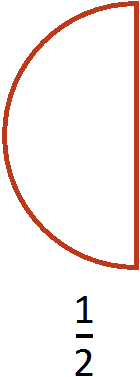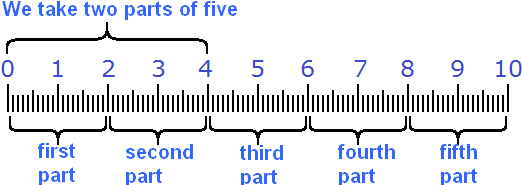We already said that a fraction is a part of something. That part can be anything. For example, ![]() of a pizza is a half of a pizza:
of a pizza is a half of a pizza:

But the usage of fractions does not end with one pizza. For example, you can find out how much is ![]() of ten centimeters:
of ten centimeters:

As you have already guessed, ![]() of ten centimeters is five centimeters. After all,
of ten centimeters is five centimeters. After all, ![]() is the simplest fraction, which means half of something. We had ten centimeters. We divided those ten centimeters in half and got five centimeters.
is the simplest fraction, which means half of something. We had ten centimeters. We divided those ten centimeters in half and got five centimeters.
Let's try to find out how much is ![]() of one hour. Recall that an hour is 60 minutes. We need to find
of one hour. Recall that an hour is 60 minutes. We need to find ![]() (half) of 60 minutes. It is not difficult to guess that half of 60 minutes is 30 minutes. So
(half) of 60 minutes. It is not difficult to guess that half of 60 minutes is 30 minutes. So ![]() of one hour is 30 minutes or half an hour.
of one hour is 30 minutes or half an hour.
Let's try to find ![]() of one centner. A centner is 100 kg. We need to find
of one centner. A centner is 100 kg. We need to find ![]() (half) of 100 kg. It is easy to guess that half of 100 kg is 50 kg. So
(half) of 100 kg. It is easy to guess that half of 100 kg is 50 kg. So ![]() of one centner is 50 kg.
of one centner is 50 kg.
Since we are doing math, it means that in most cases we will be dealing with numbers. For example, let's find ![]() from the number 12.
from the number 12.
So, we need to find half of the number 12. It is not difficult to guess that half of number 12 is number 6. So ![]() of 12 is 6.
of 12 is 6.
To make it easier to find a fraction from a number, you can use the following rule:
To find a fraction of a number, divide the number by the denominator of the fraction, and multiply the result by the numerator of the fraction.
Let's try to trace the entire process of this rule. Let's take ten centimeters as an example:

Let it be required to find ![]() of those ten centimeters. Read the first part of the rule:
of those ten centimeters. Read the first part of the rule:
To find a fraction of a number, divide the number by the denominator of the fraction ![]()
So, we divide ten centimeters by the denominator of the fraction ![]() . The denominator of this fraction is 2. Therefore, we divide ten centimeters by 2
. The denominator of this fraction is 2. Therefore, we divide ten centimeters by 2
10 cm : 2 = 5 cm
Read the second part of the rule:
and multiply the result by the numerator of the fraction ![]()
So we multiply five centimeters by the numerator of the fraction ![]() . The numerator of the fraction in this case is one. Therefore multiply five centimeters by one:
. The numerator of the fraction in this case is one. Therefore multiply five centimeters by one:
5 cm × 1 = 5 cm
We found ![]() of ten centimeters. We see that
of ten centimeters. We see that ![]() of ten centimeters is five centimeters:
of ten centimeters is five centimeters:

Why do we have to multiply the result by the numerator after dividing a number by the denominator of a fraction? The fact is that the denominator of a fraction shows how many parts something is divided into, and the numerator shows how many parts were taken.
In our example, the ten centimeters were divided into two parts (in half), and one part was taken from those parts. By multiplying one part by the numerator of a fraction, we are indicating how many parts we are taking from something. That is, by multiplying five centimeters by the numerator of the fraction ![]() , we indicated that we were taking one part of two.
, we indicated that we were taking one part of two.
Example 2. Find ![]() of 10 cm.
of 10 cm.
Apply the rule of finding fractions from a number:
To find a fraction of a number, divide the number by the denominator of the fraction, and multiply the result by the numerator of the fraction.
First, we divide 10 centimeters by the denominator of the fraction ![]()
10 cm : 5 = 2 cm
You got two centimeters. This result should be multiplied by the numerator of the fraction ![]()
2 cm × 2 = 4 cm
We found ![]() of ten centimeters. We see that
of ten centimeters. We see that ![]() of ten centimeters is four centimeters.
of ten centimeters is four centimeters.
The entire solution process can be seen in the following figure:

First, the ten centimeters were divided into five equal parts. Then two parts of those five parts were taken:

Example 3. Find ![]() of the number 56.
of the number 56.
To find ![]() of 56, divide the number by the denominator of the fraction
of 56, divide the number by the denominator of the fraction ![]() , and multiply the result by the numerator of the fraction
, and multiply the result by the numerator of the fraction ![]() .
.
So, first, we divide the number 56 by the denominator of the fraction![]()
56 : 8 = 7
Now multiply the result by the numerator of the fraction![]()
7 × 3 = 21
The answer is 21. So ![]() of 56 is 21.
of 56 is 21.
Example 4. Find ![]() of one hour.
of one hour.
One hour is 60 minutes. The assignment can be understood as finding ![]() of 60 minutes.
of 60 minutes.
First divide 60 minutes by the denominator of the fraction ![]()
60 min : 4 = 15 min
Now multiply the 15 minutes by the numerator of the fraction ![]()
15 min × 2 = 30 min
The answer is 30 minutes. So ![]() of one hour is thirty minutes or half an hour.
of one hour is thirty minutes or half an hour.
Example 5. Find ![]() of one meter.
of one meter.
One meter is one hundred centimeters. First divide 100 cm by the denominator of the fraction ![]()
100 cm : 5 = 20 cm
Now multiply the resulting 20 cm by the numerator of the fraction ![]()
20 cm × 4 = 80 cm
The answer is 80 cm. So ![]() of one meter is 80 cm.
of one meter is 80 cm.
2. If you find an error or inaccuracy, please describe it.
3. Positive feedback is welcome.